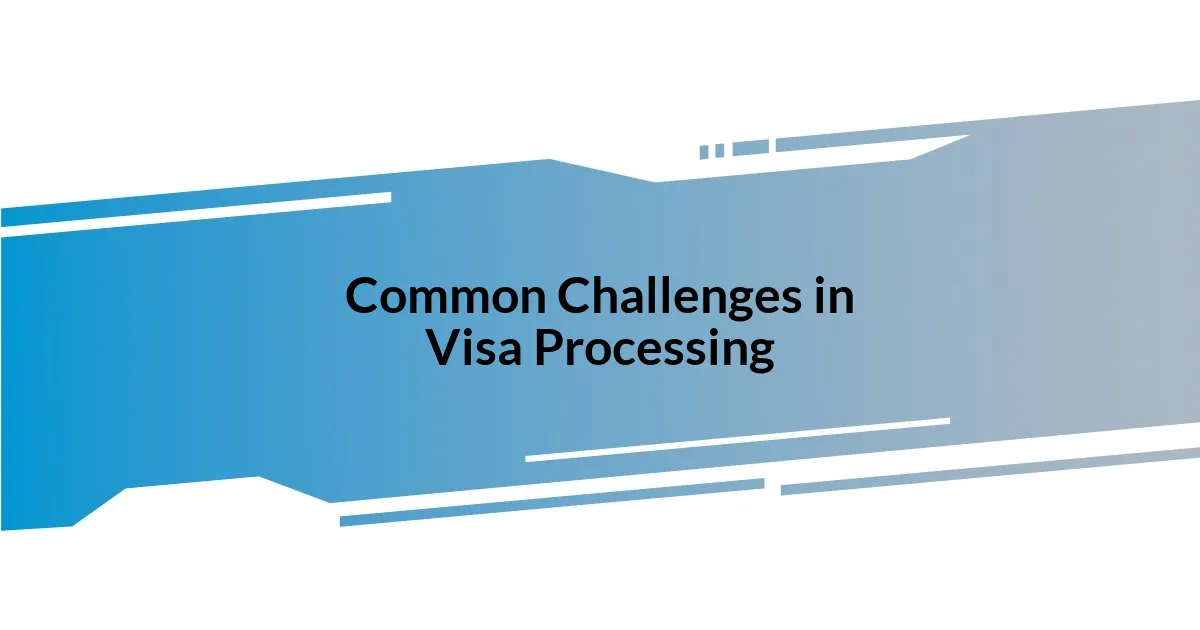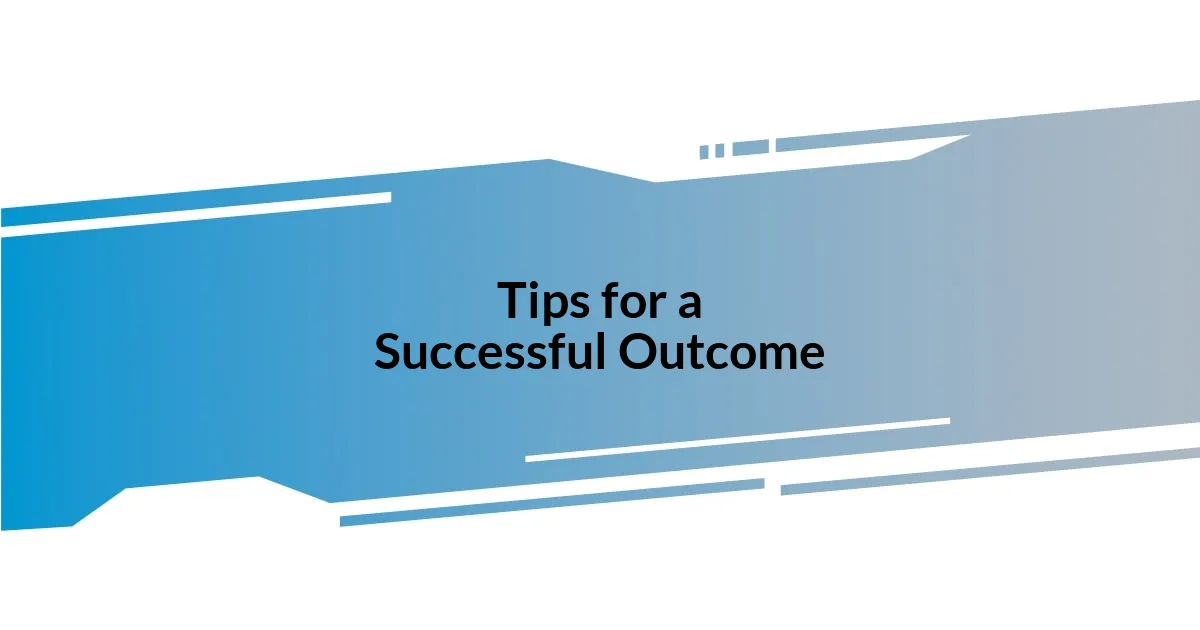Key takeaways:
- Navigating visa processing is complex and requires meticulous attention to detail in documentation and application forms.
- The interview process can transform from a stressful experience to a genuine conversation through preparation and authenticity.
- Consistency between application details and supporting documents is crucial to avoid delays or denials.
- Organizing documents and practicing responses can significantly enhance confidence and reduce stress throughout the visa application journey.

Initial Steps in Visa Processing
One of the first things I experienced during visa processing was the overwhelming amount of information available online. It felt like I was diving into a sea of forms, requirements, and regulations. Did you ever wonder how something so essential could seem so complex? Honestly, that realization made me feel both excited and anxious about navigating this new journey.
Filling out the application form was another pivotal step that stands out in my memory. I remember sitting at my desk, typing away, and ensuring that each detail was correct. Just thinking about the potential consequences of a small mistake left me uneasy. Have you felt that pressure before? I certainly did, as I understood that precision was crucial here.
Once I gathered all my documents, the next step was probably the most nerve-wracking—the submission. The moment I clicked “submit” felt surreal. It reminded me of when I sent my first job application; both had the same mix of hope and fear. What if something went wrong? Waiting for the response was a rollercoaster of emotions—each day felt like an eternity, and I couldn’t shake the feeling that I had just taken a huge leap of faith.

Gathering Required Documentation
Gathering the required documentation felt like embarking on a scavenger hunt. Each document represented a piece of my story, a vital part of proving who I was and why I was applying for the visa. I recall flipping through old boxes to find my birth certificate, which, believe it or not, had been tucked away in a corner for years. The search was not just about finding papers; it was also nostalgic, reminding me of where I came from and what I had to show for it.
Here’s a concise list of the key documents I needed to gather:
- Passport: A valid passport is essential; make sure it’s not expiring soon.
- Visa Application Form: This form required detailed personal information.
- Photographs: Specific dimensions and requirements for these photos usually apply.
- Proof of Funds: Bank statements helped demonstrate my financial stability.
- Travel Itinerary: This included flight bookings and accommodation details.
- Employment Letter: A letter from my employer confirming my position and salary was crucial.
- Supporting Documents: Depending on the visa type, this may include proof of family ties or previous travel history.
Each item on this list not only added to the pile on my desk but also deepened my connection to this process, making it feel very real. I was no longer just a hopeful applicant; I was building my future.

Understanding Visa Application Forms
Filling out the visa application forms required me to pay close attention to detail. I remember the sense of responsibility weighing on me as I navigated through each section. Did you ever get tripped up by questions that seemed simple but hidden complexities? One question asked about my travel history, and I paused, thinking back to my numerous trips, and suddenly felt proud. It was a reminder of how far I’d traveled, both literally and figuratively.
The structure of the application forms can vary significantly between different visa types, which can be quite confounding. Some are short and straightforward, while others could feel like you’re writing a mini-autobiography. This variation challenged me; I had to adapt my approach based on the requirements. Have you ever felt like you were juggling too many things at once? It’s essential to familiarize yourself with the specific guidelines each form presents to avoid unnecessary frustrations down the line.
Overall, I realized this form wasn’t merely a bureaucratic hurdle but a way to convey my intentions and aspirations. This perspective shift helped me approach the task with a more positive mindset. I wasn’t just submitting paperwork; I was outlining my dreams and goals. Reflecting on this process, I can appreciate how meaningful it turned out to be.
| Visa Application Form | Experience |
|---|---|
| Basic Forms | Minimal information required, quick to fill out |
| Complex Forms | Detailed inquiries demand thoughtful responses |
| Country-Specific Variations | Each country has unique requirements that can be overwhelming |
| Consistency Checks | Details must align with supporting documents, enhancing anxiety |

Navigating the Interview Process
Navigating the interview process felt like stepping into a new world, one filled with anticipation and a flutter of nerves. As I prepared, I kept asking myself questions like, “What will they actually want to know about me?” The day of my interview arrived, and I could feel my heart race as I walked through the door. It was a mix of excitement and dread; I was about to present my story to someone who held a key to my future.
During the interview, I found that confidence came from preparation. I practiced common interview questions repeatedly, envisioning how I would answer. It was fascinating to see how the interviewer’s eyes lit up when I spoke passionately about my goals. It made me realize that my enthusiasm was just as critical as my documentation. Did you ever notice how a well-told story can bridge the gap between anxiety and connection? I remember sharing anecdotes about my previous travels, and suddenly, the stiffness eased—it felt less like an interrogation and more like a conversation.
One key takeaway for me was the importance of being genuine. The moment I let my nerves fade and relaxed into the experience, everything shifted. I focused on sharing my true motivations for wanting the visa rather than just reciting facts. It was a moment of clarity. Have you ever experienced that breakthrough during a pressure situation? The interview became an opportunity not just for them to assess me, but for me to reflect on my aspirations too. It turned out to be less daunting than I had imagined, and that realization was liberating.

Common Challenges in Visa Processing
Fumbling with documentation was a significant challenge during my visa processing journey. I remember sorting through mountains of papers, each one seeming more important than the last. Did you ever feel overwhelmed by what felt like a never-ending checklist? One day, I lost track of my bank statements and, in a panic, realized the financial proof was vital for my application. This moment was a stark reminder that attention to every detail is crucial by the time of submission.
Consistency between my application and supporting documents also kept me on my toes. I found myself double-checking everything to ensure the details matched perfectly. It’s surprising how a simple discrepancy, like a different spelling of my name, could lead to delays or even denials. Have you ever felt that sinking feeling when you realize there’s something out of place? This pressure made the entire process feel like a high-stakes game, where one wrong move could cost me a chance at moving forward.
Lastly, dealing with varying processing times was like riding a roller coaster. After submitting all the paperwork, I experienced a mix of hope and anxiety as I waited for updates. I once read conflicting timelines online, which made me second-guess everything. Can you relate to that feeling of uncertainty? Those moments taught me the importance of patience and planning, as the waiting game can often be the most challenging part of the process.

Tips for a Successful Outcome
It’s crucial to start your visa application by organizing your documents meticulously. I can’t tell you how many late nights I spent sorting through papers and creating checklists. Have you ever had that sinking feeling of uncertainty when you can’t find a vital document? I learned the hard way that keeping everything neat and clearly labeled not only saves time but also reduces stress as the application deadline approaches.
Another key tip is to practice your responses to potential interview questions with someone you trust. I recall sitting with my best friend, who played the role of the interviewer. At first, it felt silly, but with every mock session, I grew more comfortable articulating my thoughts. It was empowering to see how sharing my story in a supportive environment allowed me to refine my answers and build the confidence needed to express my aspirations clearly.
Lastly, never underestimate the power of a follow-up email after your interview. I remember sending a brief thank-you note a day or two later. To my surprise, I received a warm reply appreciating my gratitude. It was a simple gesture, but it reminded me that these processes are fundamentally about connection. Have you ever thought about how small actions can leave a lasting impression? Taking that extra step can highlight your enthusiasm and dedication, possibly giving you an edge in the outcome.